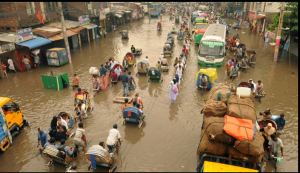The United Nations Development Programme and its partners in Bangladesh at a national policy dialogue in the city on Tuesday highlighted the importance of treating climate change adaptations and disaster risk reduction through aligned national policies and spending.
Discussion on the development of institutional mechanisms for converging disaster risk reduction (DRR) and climate change adaptation (CCA), both for policy and practice, and to use the opportunity to promote community led risk reduction measures and climate change adaptation, which has proven in the past to improve resilience.
Bangladesh is faced with a changing disaster context that warrants a new set of policy-innovations if it is to adapt to a predicted rise in the intensity and frequency of floods and cyclones resulting from global warming, said a UNDP media release.
Bangladesh is the single-most vulnerable country to the impacts of rising sea levels. In fact, the country has the highest number of people exposed to year-round hazards such as cyclones, storm surges, erratic rainfall and drought, to name but a few.
Over the past 30 years the number of people affected by cyclones, tidal surges, water logging and salinity intrusion has increased dramatically. The implications will extend to food security, energy, water, livelihoods, health and habitat. Emphasizing the need for holistic approach that takes care of both disaster risk reduction and climate change adaptation, Disaster Management and Relief Minister Abul Hassan Mahmood Ali said: “This will require new models of cooperation and coordinated policy and institutional responses across multiple sectors, agencies and ministries.”
Disaster Management and Relief Secretary Mesbah Ul Alam said: “We need to innovate ways and means for making sure that policies, planning, institutions and finance can be managed together to ensure effective development towards building more resilient Bangladesh.” Along with the Comprehensive Disaster Management Program (CDMP II) under the Ministry of Disaster Management and Relief, UNDP Bangladesh has been supporting 14 ministries/departments, and local government institutions, to produce development plans that are both disaster and climate resilient. UNDP Bangladesh Country Director Pauline Tamesis cited the example of the coastal afforestation project which uses simple innovations to combines climate resilience by reclaiming lost land, on one hand, and ensuring disaster risk reduction through the protection of a mangrove green belt along the coast, that protects inland communities from tidal surges and cyclones. “We can transform the economy to be climate and disaster smart and move towards environmentally sustainable development,” she said. Country Representative for DFID Sarah Cooke also spoke at the consultation about the economic case for resilience. She said it was far more cost-effective to enhance the capacity of people, communities and institutions before an event rather than to throwing emergency relief after it occurs. – UNB




